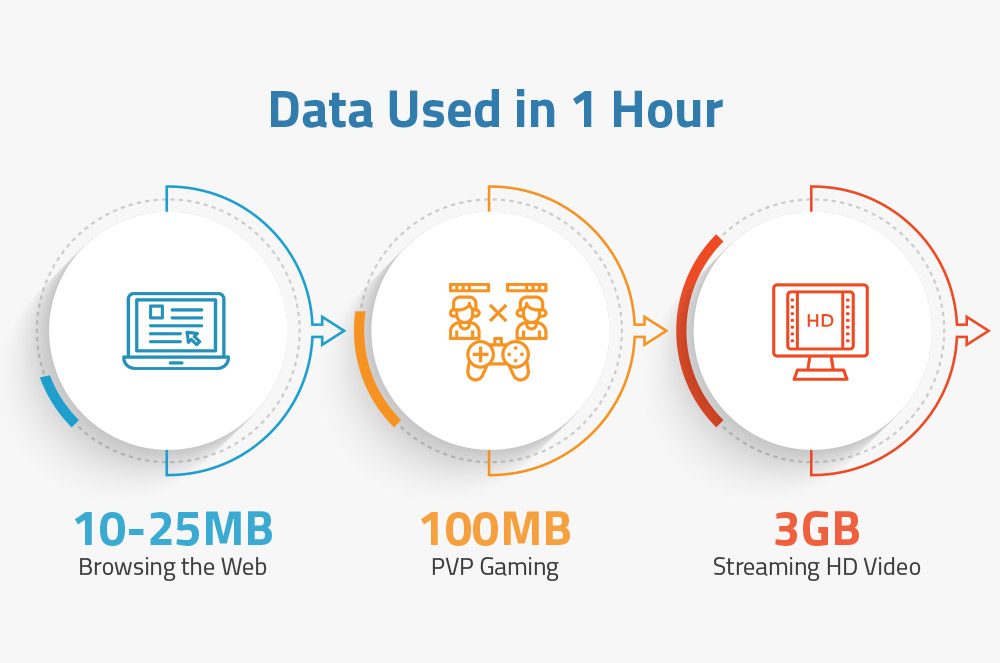
Determining Data: How much data do you really need?
Straight Talk on How Your Internet Works – #AskOasisInternet
Q: How much data do I really need?
A: There can be a lot of confusing aspects of Internet Service — packages with different speeds, amounts of data and prices can be overwhelming and confusing. Do I want 10 mbps or 2,000 mbps? Should I have 10 gigabytes of data or unlimited data? Is it worth the price tag?
In order to understand which package is the best for you, it is important to understand what these different components of your package actually mean in the first place. Perhaps the two most important parts to understand when buying an internet package are the speed (how fast your internet will be) and the amount (how much data your package allows you to use). In this article we are going to take a look at the amount of data you need, however, you can check out our article about broadband speeds here.
So what is data? Data is measured in Bytes which determine the size of the data files. The smallest size is Megabytes (MB) and the units of measurement increase by increments of 1000, from Megabytes to Gigabytes (GB) to Terabytes (TB)1. And basically everything you do on the internet requires a certain amount of data. While activities like browsing the internet or checking your email only use a small amount of data, downloading large files such as video games or streaming take up much more data2. In 2020 the average US household consumption of data is around 344 GB per month3, however, the needs of each customer is going to change drastically based on what the user plans to do on the Internet. Let’s take a look at how much data certain activities require:
- 1 hour of Web browsing: 10-25 MB4
- Online gaming like Fortnite 100MB/hour5
- Streaming Music 150 MB/hour?6
- An hour of group Zoom call 810MB to 2.4 GB7
- Send or receive 1,000 emails 1 GB8
- Streaming an hour of SD video 1 GB9
- Streaming one hour of HD video 3 GB10
- Streaming an hour of 4K video 7.2GB11
- An hour of Youtube in HD 3 GH12
- Downloading a video game such as Call of Duty: Warzone 101GB13
With data packages running from a few gigabytes to unlimited, it is often hard to understand what you could really do within your data cap. As an example, you could do any one of the following activities with 100 GB of data14:
- 5000 Hours browsing
- 25,000 Music Tracks
- 650 Hours streaming music
- 320 Hours of Skype
- 800 App Downloads
- 100 SD Movie downloads
- 40,000 Emails
So why is choosing your data cap so important?
1. Overage Fees
Some Internet Service Providers charge overage fees if you go over your data cap. The fees are often charged in increments, for example for every extra 50GB of data you use, you could be charged $1015. It’s not unheard of to see an extra bill line item for $100 with some carriers!, However, at Oasis Broadband, we understand that it is hard to estimate your data needs and exceeding your data cap will happen. This is why we offer data forgiveness. We will happily reverse overage fees if you simply call our customer support team and ask. That way, you can rest easy knowing that even if your child secretly downloads a video game that exceeds your data limit, you won’t have a surprise expense, and we can rest easy knowing that our customers are satisfied.
2. Throttled Speeds
While some providers may not charge you for using extra data, they may throttle your speeds, meaning they will slow your connection down16. However, we never throttle speeds at Oasis Broadband. We believe that our customers should get the speeds they are paying for, even if they go over their data cap.
Now that you understand what data is and why it is important to make sure your provider is forgiving and transparent, we hope you will feel more confident when purchasing your internet package. If you want to learn more about what packages we can offer you, enter your zip code here to find the Oasis Broadband Services Available for your location.
(1) (2) (3) (4) (5) (6) (7) (8) (9) (10) (11) (12) (13) (14) (15) (16)